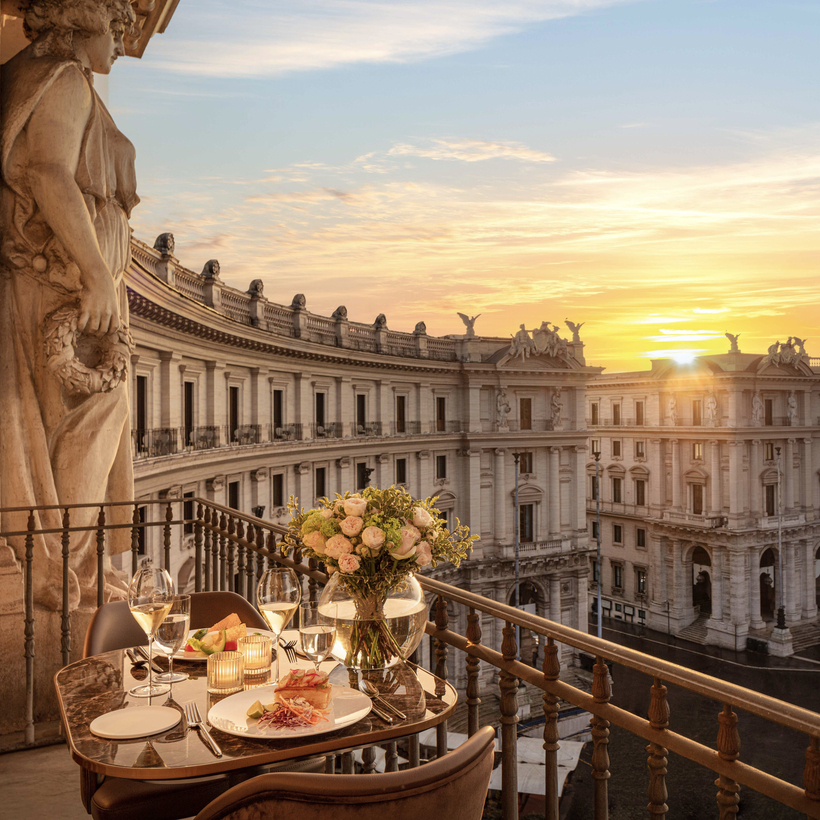“Dom Pérignon or Krug?” the dark-eyed waiter asked as I stepped onto the leafy rooftop terrace on a warm summer evening. I was tempted to answer “Both,” but then I wouldn’t have had a free hand to grab the caviar-topped canapés on a tray that was lingering near my elbow.

The opening party for the Bulgari Hotel Roma was clearly intended to be a Lucullan feast—completely appropriate when in Rome. It was as splashy as they come, but Rome is now accustomed to such opulence around the opening of a new hotel. After decades during which the Dorchester Collection’s impeccable Hotel Eden and Rocco Forte’s Hotel de Russie jostled for the top position (alongside the charmingly tired but still classic Hotel Hassler), Forte opened his second property in the city, in 2019. Hotel de la Ville is now looming large at the top of the Spanish Steps, but these days it has even more competition. After the pandemic, the pace of openings increased dramatically.
W Hotels & Resorts made its Italian debut at the end of 2021 with two adjacent 19th-century palazzos just a few blocks south of the Porta Pinciana entrance to the Villa Borghese gardens. An excellent restaurant and a rooftop pool are two compelling reasons to try it. At the nearby Piazza della Repubblica, the Anantara Palazzo Naiadi (formerly known as the Boscolo Palazzo Naiadi) finished its renovations last year. Overlooking the Fountain of the Naiads, the palazzo is considered one of Rome’s most remarkable examples of Art Nouveau architecture.

March saw an Italian debut from the wellness-oriented Six Senses group. It’s located just off the frenetic Via del Corso, next to the beautiful concave façade of San Marcello al Corso church, and its ancient walls contain a high-tech spa that includes contemporary Roman baths and L.E.D. face masks. Patricia Urquiola’s interior design hews to the theme; the locally sourced travertine limestone and cocciopesto plasterwork in peaceful, muted colors impart a sense of calm. To round off the feel-good experience, order one of the pistachio pizzas, but don’t be surprised if it takes a while to get to your table. The hotel is still new, and its service is not quite up to snuff.
Pistachio, or perhaps olive, is the color that dominates the 93-room Rome Edition, which marks hotelier Ian Schrager’s first Italian property. It opened to the public in June in what the hotel refers to as a “preview phase.” The Web site displays only renderings of the rooms, but they look much better in person. The hotel’s verdant courtyard entrance sets the tone, but inside the lobby, plants and acres of velvet curtains and cushions ensure that the Edenic theme continues. The only departure is found in the Yves Klein–blue dining room, where chef Paola Colucci sends out crowd-pleasing dishes such as spaghetti with roasted-datterino-tomato sauce, smoked ricotta cheese, lemon zest, Parmesan cheese, and basil.

Of all of these new hotels, the most appealing is the Bulgari Hotel Roma, and not only because of the Krug and caviar. It’s a hometown affair for this global luxury house, which was founded in 1884 when Greek silversmith Sotirio Bulgari set up shop at Via Sistina. Now owned by LVMH and dabbling in much more than just fine jewelry, Bulgari’s hospitality arm is extending its reach. Now there are nine Bulgari hotels around the world, and its 114-room Roman outpost is among the most opulent.

Located in a Rationalist building designed by Vittorio Ballio Morpurgo in 1936, it is situated along the Tiber River and has views of the tomb of Emperor Augustus. A basic room starts at nearly $1,500 per night, and the Bulgari Suite, at 3,200 square feet, fetches an eye-watering rate of $38,000. (At least it includes a dining room.) And there’s no need to go out for dinner. Chef Niko Romito, who oversees the restaurants and already hot Bulgari Bar, has three Michelin stars and does room service.
Given all the effort and expense, the Bulgari’s flashy housewarming was not entirely unjustified. Under the setting sun, certain bejeweled guests compared their glittering Serpenti bracelets with flashing eyes of emerald, ruby, and sapphire. Décolletage heaved beneath the weight of fan-shaped, diamond-encrusted necklaces, and paid spokespeople such as Zendaya and Priyanka Chopra twirled and posed for the cameras.

As the night wore on, 200 drones took to the skies above the tomb of Emperor Augustus to illuminate the darkness with a light performance that was visible across Rome’s dome-studded skyline. Among Augustus’s best-known missives: Inveni urbem roman lateres, revertor ad marmoris. “I found a city of bricks and left it a city of marble.” No kidding.
Mary Lussiana is a Lisbon-based travel writer and reviewer of hotels
Rates at the Bulgari Hotel Roma begin at $1,500 per night; the W Rome, from $400; Anantara Palazzo Naiadi, from $400; Six Senses Rome, from $1,200; the Rome Edition, from $700


